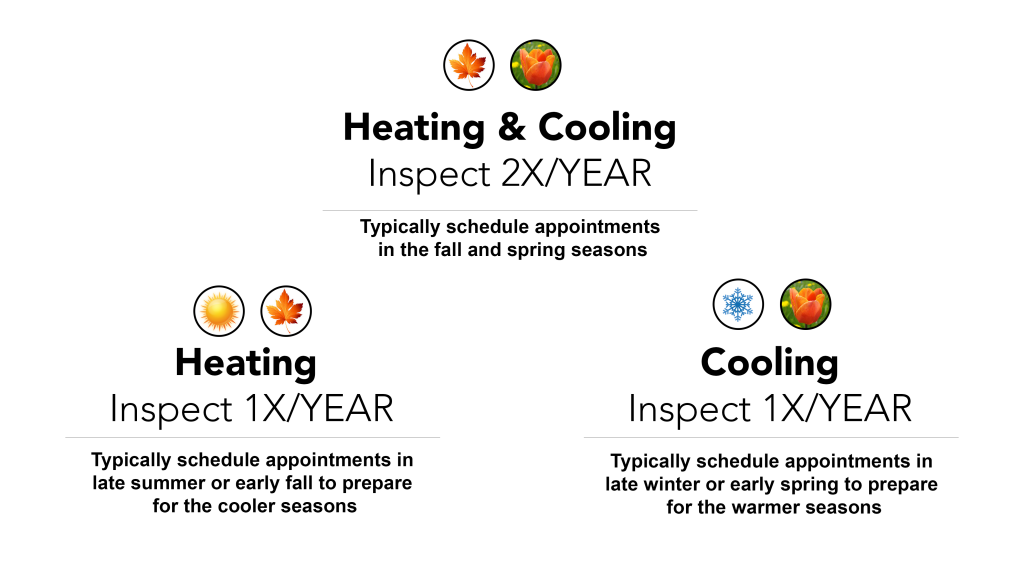HVAC inspections give you a snapshot of how your home’s heating and cooling systems are functioning. Having standard inspections done can help you to prepare and save up for any repairs that may be coming down the road and proactively address any part replacements. Most professionals recommend having both your heating and cooling systems inspected annually.

What an HVAC Inspection Includes
Although what is included in an inspection can vary depending on the professional conducting it, in general, HVAC inspections usually include the following:
Late Winter/Early Spring HVAC Preventative Maintenance Checklist
During a yearly maintenance appointment for your cooling system, your HVAC technician will typically perform the below tasks to prepare it for the warmer months.
- Clean or replace filters
- Clean condenser and evaporator coils
- Clean drain lines for proper flow and clear clogs
- Clear drain pans of any standing water to avoid overflows
- Replace worn pulleys and belts
- Inspect ducts for mold, dust, and debris
- Observe humidity levels
- Check refrigerant charge and for leaks
- Test thermostats and controls to make sure temperatures and timer functions are correctly set
- Change batteries
- Check electrical system and connections
- Check fan motor
- Check blowers and blades for proper airflow
- Lubricate motors bearings and moving parts
- Inspect cabinet for leaks and check cabinet door for secure closure
- Check for debris around the outside unit
- Fall/winter HVAC preventative maintenance checklist
During a yearly maintenance appointment for your heating system, your HVAC technician will typically perform the below tasks to prepare it for the cooler months.
- Replace filters on heating equipment
- Inspect ignition burner assembly
- Examine heat exchanger or heating elements
- Study flue system and ensure secure attachment to the furnace
- Inspect for gas leaks with gas furnaces
- Assess gas pressure
- Check pulleys and belts
- Clear drain lines and pans
- Check electrical connections
- Lubricate motors, bearings and other moving parts
- Check thermostats and controls
- Check fan and blower operations and adjust as needed
- Inspect heat pump
- Examine ductwork and vents
Once they complete the HVAC unity inspection your technician will typically provide you with a report of their findings and any recommendations they may have. Be sure to ask any questions you may have and work with the technician to create a plan of action for addressing any concerns the examination may have uncovered.
DIY HVAC Maintenance Tips
These popular internet tips suggest ways to gauge the status of your system and to prepare for a maintenance technician to service your unit. Be sure not to excessively tamper with your unit and run the risk of voiding any warranties you may have. When in doubt, err on the side of caution and contact your dealer or a technician with questions.
Outdoor Maintenance
- Keep the area around the main cabinet and control box clear and easy to access. Cut any high grass and clean away any dirt, leaves, and debris.
- Inspect the base pan for anything that could block the drain openings. A plugged drain can cause water damage and affect humidity levels in your building.
- Inspect the cabinet and coil for any leaks or holes. You may opt to clean the evaporator or condenser coils in your cooling system to help the system run more efficiently. Dirty coils cause the system to run longer just to complete the same tasks.
- Inspect the fan blades for any wear or damage. Be sure to check them both while they’re in motion and stationary.
- Check to make sure the moving parts within your system are properly lubricated. Parts that lack lubrication may cause friction in your motor and reduce your system's efficiency.
Indoor Maintenance
Do you have any HVAC tips? Comment below to share your thoughts.